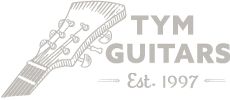Late 60's/early 70's Kawai SEN
Share
I've owned (and still do) quite a few of these guitars and most don't have any markings at all. No brand, no model, no serial numbers. It's one of the things I LOVE about old Japanese (and Mosrite) guitars that so many things were made, under so many different names, and still after collecting/buying/selling these things for nearly 30 years, I still see the same guitar with different and new names or things I haven't seen before.

I have however seen a few of these.
This shape was started in '68 after Kawai took over Teisco and it was a popular guitar sold under many different names around the world. It's probably most famous as the Silvertone 1445 as sold in the US from '68 to about '74.


Kawai was a huge manufacturer formed in 1927 who managed to ride out the late sixties decline of Japanese guitars with the help of being a major manufacturer of keyboards. Making pianos, and then electric pianos, drum machines and synths and are still going strong today with digital pianos they entered the guitar market in '63 with some "US inspired" shapes of good playable quality. The SD series of late '63 is one of my personal favourites and although I've sold a few through the shop, I have a personal one which is very dear to me.

In the late sixties Kawai bought Shinko and then one of the biggest names in Japanese guitars at the time, Teisco. The boom was soon to be over but Kawai kept pushing forward and thanks to a great distribution set up for their pianos/keyboards, they could ship these guitars everywhere with any name (or no name) on the headstock for great retail prices.
Silvertone in the US sold LOTS of these and they were available in many different formats.


While this "shape" was a Kawai SEN 100 to 140 (depending on specs) and the bass version was an EB-140 they were sold in Australia as Audition, Coronet and Kawai with and without branding on the headstock in many different versions.

They were available in 2, 3 and 4 pickup versions, with the standard chrome edge square pole Kawai pickups, as most Silvertones had and with these "gold foil" (with black inserts) pickups as used on many Teisco KImberly (EKO Kadett) guitars of the time. They're a strong, great sounding pickup.
Three pickup versions usually ran a single pickup in the bridge and two pickups grouped together in the neck although they weren't RWRP to make it humbucking and the pickups were all wired in parallel.

They were also available in bound, or non bound bodies and the German carve, while being shallow due to the body thickness is a great organic carve. The bound body ones really set the shape off beautifully.
The necks were available in no blocks or binding right up to fully multi layer binding and block inlay with bound headstock all with a zero fret. Headstocks were generally this sort of 80's Ibanez six a side shape.


Some had a Jaguar style chrome plate with two, three or four switches for pickup selectors and several different vibratos were used depending on the model. The 140 had the very nice Teisco Mosrite inspired vibrato like on this ELK version (below) while the cheaper versions had a more Fender Offset inspired version like this one. Bridges also differed with vibrato and model.

Kawai made good to great quality guitars throughout the sixties and seventies and models were pitched at price points within any brands particular catalogue. Cheaper simple guitars were sold at entry level prices with good but simple hardware while top of the line Kawais were using great quality parts as used on many high end Teiscos of the time.
The bodies are thin solid timber and the finish work on all the versions is great. The Teisco-Gen-Gakki factory was abandoned for production soon after the buyout and all production moved to Kawais own factory and all these post buyout Teiscos and Kawais (under MANY different brands) were built in house.

The rarer ELK (primarily made by Teisco-Gen-Gakki) version here has three evenly spaced screw head pole piece pickups and sliders instead of knobs. I have seen an ELK version with bound body, four pickups and built in fuzz years ago, but it's the only one I've ever seen.

Kawai were no strangers to making Mosrite inspired shapes (SC-80) but I think this shape was their finest in this area. They're a great looking guitar and play and sound really good after a good service and set up.

